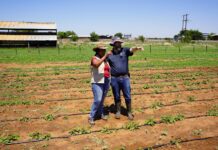By Paul Makube, Senior Agricultural Economist, FNB Commercial
The latest update on South Africa’s food inflation shows a further downside surprise to 3.9% year-on-year (y/y) in October 2025 from after decelerating from a 2025 peak of 5.5% in July to 5.2% and 4.4% in August and September, respectively.
The modest deceleration in vegetables by 5.6 percentage points (ppts) from the previous month, fruits and nuts (-3.7ppts), sugar, confectionery and desserts (-0.5ppts), and meat (-0.3ppts) categories more than offset gains in cereal products (0.4ppts), milk, other dairy products and eggs (0.1ppts), and oils and fats (+0.1ppts) prices.
Monthly, food inflation remained in deflation for the third consecutive month after easing by 0.1% month-on-month (m/m) in October 2025.
Vegetable inflation remained on the downside underpinned by massive declines in big-ticket items such as fresh potatoes and onions which fell by 30.9% and 4.5% y/y respectively in October 2025.
Meat lost steam after surging to record highs in the past few months due to a combination of consumer demand constraints and improved availability domestically.
Meat inflation slowed but still at double-digit levels of 11.4% y/y in October from 11.7% y/y in September, further steadying on a month-on-month basis.
While cereal products inflation at consumer level eased by 0.4 ppts from September to 2% y/y in October 2025, the underlying raw product prices continue to trend a record lows. For example, the average monthly white maize prices recently declined by 35.3% (-R1,980/t) y/y at R3,627/t while its yellow counterpart fell by 1.4% (-R953/t) y/y to R3,493/t in October 2025 which signals a potential reversal of the cereal inflation trajectory in the medium term. Wheat prices eased by 0.6% (-R37/t) y/y at R5,911/t during the same period.
The combination of a massive 2024/25 commercial summer crop harvest and the excellent 2025/26 seasonal outlook underpin the current downturn in producer prices. Recently, the National Crop Estimates Committee’s First Intentions to Plant report showed that farmers are likely to increase their 2025/26 summer crop plantings by 1.3% y/y to 4.50 million hectares. South Africa’s major crops, such as maize and soybeans, will see planted area increasing by 2.3% and 2.5% y/y respectively to 2.67 million and 1.18 million hectares.
However, the continued foot-and-mouth disease (FMD) induced disruptions to trade remain a concern for the livestock industry despite efforts at vaccinations currently being executed across the country.
Finally, when considering the downturn in the interest rate outlook, better 2025/26 seasonal production conditions with a return of the La Nina weather pattern, and a resurgent rand exchange rate which has recently broke below the R17/US$ level since February 2023, we expect further downside surprises in food inflation outcomes in the medium term.









